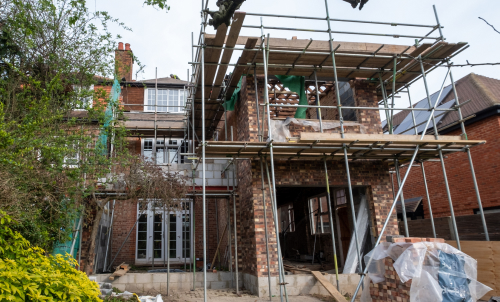
Loan-to-Value (LTV) is a key metric in the mortgage world, and it affects almost everything from your interest rate to your chances of approval. Whether you are a first-time buyer or existing homeowner, or an experienced property investor, understanding LTV will help you navigate mortgage deals more effectively.
Lenders often describe products by their LTV. For example, a 90% LTV mortgage means the loan equals 90% of the property's value. In this article, we will explain what LTV is, how to calculate it and why it matters. We will also consider how LTV influences mortgage rates, approval chances and your options when remortgaging.
What is LTV (Loan-to-Value)?
When talking about mortgages, loan-to-value ratio (LTV) refers to the proportion of the property’s value that you are borrowing. In simple terms, it is the amount of your mortgage compared to the value of the property you are buying or remortgaging. LTV is expressed as a percentage. For example, if you purchase or remortgage a home worth £250,000 with a £25,000 deposit or equity, you will need a £225,000 loan – this works out to 90% LTV because the loan is 90% of the home's value. In this case, you have a 10% deposit or equity and you have borrowed 90%.
How to Calculate LTV
Calculating LTV is straightforward:
- Find the property value and loan amount: Determine the current value of the property and the mortgage amount that you propose to borrow. For a purchase, the loan amount is the purchase price minus your deposit. For a remortgage, use the outstanding loan balance.
- Apply the formula: Divide the loan amount by the property value, then multiply by 100 to get a percentage.
Example: Suppose your property is valued at £300,000 and you have an outstanding mortgage of £250,000. Divide £250,000 by £300,000, which equals approximately 0.83. Multiply 0.83 by 100, and you get 83% LTV. This means that 83% of your home's value is financed by the loan, and the remaining 17% is your own equity. The lower the LTV, the more equity you have in your property. A lower LTV generally also indicates less risk for the lender, which can translate into your being able to obtain a relatively lower mortgage rate.
Why LTV Matters for Your Mortgage
LTV has an impact on your mortgage interest rate, the range of deals available and even whether you will be approved. Lenders use LTV as a risk indicator: a higher LTV (meaning you are borrowing a larger portion of the property’s value) is riskier for the lender, while a lower LTV is safer. Here are a few key ways LTV matters:
- Interest Rates: The interest rate you’re offered often depends on your LTV. Usually, the smaller your deposit and the higher the LTV, the higher the interest rate you are likely to pay, because the lender is taking on more risk. Conversely, a larger deposit and lower LTV usually gets you a better rate. Lenders typically have tiered LTV-related rate bands; for example, rates at 95%, 75% and 60% LTV, with the best rates at the lower LTV bands. According to MoneyHelper (a financial guidance service), a 40% deposit (resulting in a 60% LTV) can unlock some of the most competitive mortgage rates. At the other end of the spectrum, if you only have a 5% deposit (and 95% LTV), you should expect significantly higher interest rates due to the increased risk to the lender.
- Approval Chances: LTV can also influence whether you qualify for a loan at all. Many lenders have maximum LTV limits. For most standard residential mortgages, the maximum LTV is around 90% to 95%, meaning that you need a deposit of at least a 5–10%. If your LTV is too high, some lenders might not approve the loan. On the other hand, a low LTV (for example, 60% or lower) can make it much easier to be approved since the lender’s money is better protected by the property’s value.
- Risk and Default: From the lender’s perspective, LTV is directly tied to risk. The higher the LTV, the less equity buffer there is if property values fall or if the borrower runs into financial trouble. This is why lenders charge more and set stricter terms for higher-LTV loans, as there’s a greater chance that they won’t get all their money back if things go wrong.
- Remortgaging and Future Flexibility: LTV isn’t static – it changes over time as you pay down your loan principal and as your property value goes up (or down). This becomes important when you remortgage (or switch to a new mortgage deal). If your home’s value has increased and you’ve paid off a chunk of the mortgage, your LTV will have gone down. A lower LTV can qualify you for a better interest rate when remortgaging, since you’ve moved to a safer LTV band. For example, if you bought with a 90% LTV and a few years later your LTV is down to 75%, you might find more attractive refinancing deals.
LTV for Different Buyers and Mortgage Types
- First-Time Buyers: First-time buyers often have smaller deposits, so it is common to see higher LTVs when people are buying their first home. Many first-time buyers take out mortgages in the 90–95% LTV range (meaning only with a 5–10% deposit). The trade-off is higher interest rates and fewer product choices at these high LTVs. First-time buyers should be aware that even though some lenders or government-backed schemes can facilitate a 5% deposit deal, improving your LTV by saving a bit more deposit or choosing a cheaper property could save you a lot in interest. Also note that lenders scrutinize high-LTV applications carefully, so a strong credit history and stable income are even more important if you are borrowing with a minimal deposit.
- Homeowners and Home Movers: If you are moving from to another home or simply refinancing your current home, LTV is still crucial. Homeowners who are moving often use equity from their existing property as a deposit on the next one. This can result in a mid-range LTV; many home movers have LTVs around 60–80%, since their previous home’s equity boosts their deposit. Having a moderate or low LTV gives you access to a wider range of mortgage products and often the lowest interest rates. If you’re remortgaging your own home, hitting certain LTV thresholds (such as 60% or 75%) can qualify you for cheaper rates on a remortgage deal. For instance, a 60% LTV tends to unlock some of the best deals in the market.
- Buy-to-Let Investors: For those buying property as an investment, LTV takes on a slightly different angle. Buy-to-let (BTL) mortgages usually require a larger deposit. It is common for BTL lenders to cap LTV at around 75%; in other words, you need a deposit or equity of at least a 25%. Often, you need more. The reason is that lenders consider landlords a higher risk. The National Landlords Association found at one point that the average BTL loan was about 67% LTV, with over half of landlords borrowing more than 70% of their property value. That leverage can boost returns when house prices rise, but it can hurt if prices fall or interest rates go up.
Importantly, BTL lenders also impose another test: your rental income typically must comfortably cover the mortgage payments; often they require the rent to be 125% or more of the interest payment. A lower LTV can help here too, since a smaller loan means smaller interest payments, making it easier to meet the rental coverage ratio.
Experienced investors often manage their portfolio LTV to balance growth and risk – they may refinance mortgages to pull out equity (increasing LTV) to buy new properties, but they’ll be mindful not to over-leverage. High LTV in the investment world can lead to negative cash flow or vulnerability if house prices dip. Thus, for buy-to-let, 75% LTV is a common ceiling for good reason.
Conclusions
Loan-to-Value might just seem like yet another figure, but it is a central piece of your mortgage puzzle. It influences how much a lender will let you borrow and what interest rate you will pay. By understanding LTV, you can make strategic decisions. For example, waiting to save a bigger deposit could push your LTV down and save you thousands in interest, or overpaying your mortgage when you can afford to might drop you into a better LTV band for remortgaging.
Whether you are stepping on to the property ladder for the first time or expanding a rental portfolio, keeping your LTV in a sensible range is important. It is not just about getting approved, but also about financial resilience. A mortgage with a comfortable LTV means you have a cushion of equity that can protect you, as well as the lender, in uncertain markets. In summary, LTV is a vital gauge of both opportunity and risk in property buying. Manage it wisely, and you will reap the benefits of better rates and greater peace of mind as a homeowner or investor.










